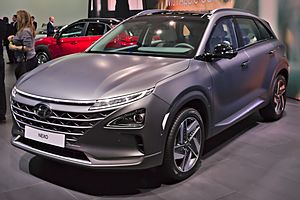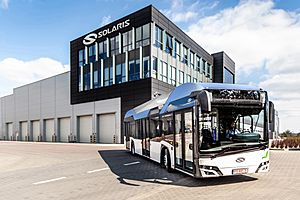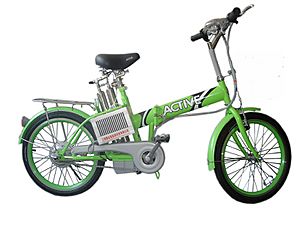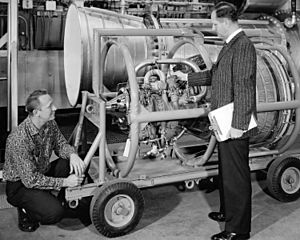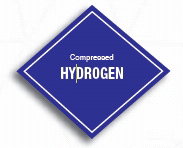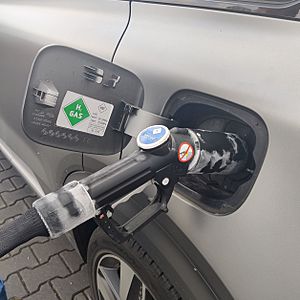Hydrogen vehicle facts for kids
A hydrogen vehicle is a type of vehicle that uses hydrogen fuel to make it move. This includes cars, buses, ships, airplanes, and even space rockets! Hydrogen vehicles create power in two main ways. One way is by using a fuel cell. This cell mixes hydrogen with oxygen to make electricity, which then powers electric motors. The other, less common way, is by burning hydrogen in a special engine, much like how gasoline engines work.
As of 2021, you can find two main types of hydrogen cars for sale in some places: the Toyota Mirai and the Hyundai Nexo. The Toyota Mirai was the first car made specifically to run on hydrogen fuel cells. There are also buses that use fuel cells. Hydrogen airplanes that carry many passengers are still being developed and might not be ready until the 2030s or later.
Most hydrogen (about 98%) is currently made from natural gas. This process releases carbon dioxide, which is a greenhouse gas. Hydrogen can also be made from water using electricity, or from other natural materials. However, these methods are usually more expensive right now. Scientists are working on ways to make hydrogen cheaper and in larger amounts, so it can compete with hydrogen made from natural gas.
Hydrogen vehicles can travel a long way on one tank of fuel. But they also have some challenges. Making hydrogen from natural gas creates carbon emissions. The vehicles themselves can be expensive. Hydrogen also takes up a lot of space unless it's super cold or highly compressed. Building enough places to refuel hydrogen vehicles around the world is also a big and costly project. Plus, if hydrogen leaks, it can warm the planet much more than carbon dioxide.
Contents
Types of Hydrogen Vehicles
Hydrogen can power many different kinds of vehicles. This includes cars, buses, forklifts, trains, canal boats, ships, aeroplanes, submarines, and rockets. NASA even used hydrogen to launch its Space Shuttles into space! There's even a toy car that runs on solar power. It uses a special fuel cell to store energy as hydrogen and oxygen, then turns it back into water to release the energy.
Hydrogen Airplanes
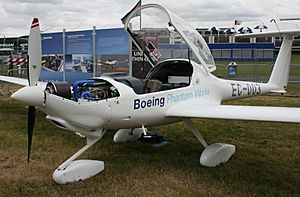
Some companies like Boeing are looking into using hydrogen as fuel for airplanes, both with and without pilots. In 2008, Boeing tested a small plane powered by a hydrogen fuel cell. Unmanned hydrogen planes have also been tested. For very large passenger planes, hydrogen fuel cells might be used for backup power instead of powering the main engines.
In 2010, Boeing showed off its Phantom Eye drone. This drone used two car engines that were changed to run on hydrogen. In Britain, a plane called the Reaction Engines A2 has been suggested. It would use very cold liquid hydrogen to fly super fast and long distances.
Hydrogen Cars
As of 2021, the main hydrogen cars you can buy are the Toyota Mirai and the Hyundai Nexo. The Honda Clarity was also made until 2021.
The first car to run on a hydrogen fuel cell was the Chevrolet Electrovan, made by General Motors in 1966. In 2002, the Toyota FCHV and Honda FCX became the first hydrogen fuel cell cars approved for commercial use. The Honda FCX Clarity, released in 2008, was the first hydrogen car designed for mass production. Honda was also the first company to let regular people lease hydrogen fuel cell cars.
The 2013 Hyundai Tucson FCEV was also offered for lease. Hyundai said it was the first mass-produced hydrogen fuel cell car. However, not many were sold because they were expensive and there weren't many places to refuel them. The Hyundai Nexo, which replaced the Tucson in 2018, was named the "safest SUV" by Euro NCAP in 2018.
Toyota launched the Toyota Mirai in Japan in late 2014. It then started selling the car in California and parts of Europe in 2015. The Mirai can travel about 312 miles on a full tank and takes only about five minutes to refuel. It cost around $69,000 in Japan. By the end of 2019, Toyota had sold over 10,000 Mirai cars.
In 2015, Toyota announced that it would share all its 5,680 patents for hydrogen fuel cell cars and refueling stations for free. This was to help other companies develop hydrogen vehicles and grow the market. However, by 2017, many car companies, including Daimler, had stopped developing hydrogen cars and started focusing more on electric cars that use batteries. By 2020, only a few car companies were still planning to make hydrogen cars.
Hydrogen Car Racing
A special Ford Fusion Hydrogen 999 Fuel Cell Race Car set a speed record of 207.297 miles per hour in 2007. It used a large oxygen tank to get extra power. The fastest speed ever for a hydrogen-powered vehicle is 286.476 miles per hour. This record was set by Ohio State University's Buckeye Bullet 2 in 2008.
In 2007, a racing group called the Hydrogen Electric Racing Federation was created for hydrogen fuel cell vehicles. They even held a 500-mile race called the Hydrogen 500.
Hydrogen Buses
Many companies have tested fuel-cell buses in different places. For example, Solaris Bus & Coach introduced its Urbino 12 hydrogen electric buses in 2019, and many were ordered. However, in 2022, the city of Montpellier, France, canceled a plan to buy 51 hydrogen buses. They found that hydrogen buses cost six times more to run than electric buses.
Hydrogen Trams and Trains
In 2015, China South Rail Corporation (CSR) showed off the world's first tram powered by a hydrogen fuel cell. Tracks for this new vehicle have been built in seven Chinese cities. In 2018, the first fuel-cell powered Coradia iLint trains started running in northern Germany. These trains store extra power in lithium-ion batteries.
Hydrogen Ships
As of 2019, hydrogen fuel cells are not usually used to power large, long-distance ships. But they are being considered for smaller, slower electric boats, like ferries, to help them travel further. Hydrogen stored in ammonia is also being looked at as a fuel for long-distance shipping.
Hydrogen Bicycles
In 2007, a company in China showed a hydrogen-powered bicycle. In 2014, scientists in Australia created their Hy-Cycle model. That same year, Canyon Bicycles started working on their Eco Speed concept bicycle.
In 2017, a French company called Pragma Industries made a bicycle that could travel 100 kilometers (about 62 miles) on one hydrogen cylinder. In 2019, they improved it to go 150 kilometers (about 93 miles) with electric help. The first 200 of these "Alpha Bikes" were given to journalists at a big meeting in France.
Some people wonder why you would use electricity to make hydrogen, then turn it back into electricity to charge a bike battery. They point out that you can charge a battery-powered bike anywhere. Also, hydrogen bikes need special, expensive filling stations that can only refuel a few bikes a day.
Military Vehicles
General Motors' military division, GM Defense, focuses on hydrogen fuel cell vehicles. Their SURUS (Silent Utility Rover Universal Superstructure) is a flexible electric platform with self-driving abilities. Since 2017, the U.S. Army has been testing the Chevrolet Colorado ZH2 truck on its bases. They want to see if hydrogen vehicles work well for military missions.
Motorcycles and Scooters
Companies like ENV are developing electric motorcycles powered by hydrogen fuel cells, such as the Crosscage. Other companies are working on hydrogen scooters. There are also hybrid scooters that use both hydrogen fuel cells and electricity, like the Suzuki Burgman fuel-cell scooter. A company in Taiwan even tested 80 fuel-cell scooters on the street.
Forklifts
A hydrogen forklift is a type of industrial truck that uses hydrogen fuel to lift and move materials. The first production hydrogen forklift was shown in 2008. It used a diesel engine that was changed to run on hydrogen.
By 2013, over 4,000 fuel cell forklifts were used in the US. Many companies use electric forklifts indoors to avoid emissions. Fuel-cell forklifts have advantages over battery-powered ones because they can be refueled in just 3 minutes. They also work well in cold warehouses, as their performance doesn't drop in lower temperatures.
Rockets
Many large rockets use liquid hydrogen as fuel, along with liquid oxygen. One big advantage of hydrogen rocket fuel is that it gives a very high exhaust speed. This means a rocket needs less fuel to speed up. Hydrogen also has more energy per pound than any other fuel.
However, liquid hydrogen is very light and needs to be kept super cold. This means rockets need bigger, insulated, and heavier fuel tanks. This adds weight to the rocket, which can reduce how far it can go. Also, liquid hydrogen slowly boils away, so rockets must be fueled shortly before launch. This makes them less suitable for missiles that need to be launched quickly.
Hydrogen fuel cells were also used in the Space Shuttle to power its electrical systems. The fuel cells produced water as a byproduct, which the astronauts could drink and use for other needs in space.
Heavy Trucks
United Parcel Service started testing a hydrogen-powered delivery truck in 2017. In 2020, Hyundai began making its Xcient fuel cell trucks and sent ten of them to Switzerland. In 2022, five hydrogen fuel cell trucks in Australia started transporting zinc from a mine to a port.
How Hydrogen Engines Work
Internal Combustion Vehicles
Hydrogen internal combustion cars are different from hydrogen fuel cell cars. They are slightly changed versions of regular gasoline cars. These hydrogen engines burn fuel in the same way gasoline engines do. The main difference is what comes out of the exhaust pipe. Gasoline engines produce mostly carbon dioxide and water, plus other gases. Hydrogen engines mainly produce water vapor.
The first engine to run on hydrogen was designed in 1807 by François Isaac de Rivaz. In 1965, a high school student named Roger E. Billings changed a Model A car to run on hydrogen. Later, in 1970, Paul Dieges patented a way to modify gasoline engines to use hydrogen.
Mazda has developed special Wankel engines that burn hydrogen, used in their Mazda RX-8 Hydrogen RE car. A benefit of using these types of engines is that it costs less to change factories to produce them.
Fuel Cells
A fuel cell is like a battery that never runs out, as long as it has fuel. It creates electricity by combining hydrogen and oxygen.
Fuel Cell Cost
Hydrogen fuel cells can be expensive to make because they need rare materials, like platinum, which acts as a catalyst (a substance that speeds up a chemical reaction). In 2014, it was thought that Toyota might lose about $100,000 on each Mirai car sold at first. In 2020, scientists started working on a new type of catalyst that uses much less platinum. This could help make fuel cells cheaper in the future.
Cold Weather Performance
Early fuel cell designs had problems working in very cold temperatures, affecting how far they could go and how quickly they could start. However, these issues have mostly been solved. Users in 2014 said their fuel cell vehicles worked perfectly even in freezing temperatures, without losing much range, even with the heaters on.
Fuel Cell Lifespan
The lifespan of fuel cells is similar to that of other vehicle parts. For example, some fuel cells can last for 7,300 hours when used in different conditions.
Hydrogen Fuel
Hydrogen doesn't exist naturally in large amounts like oil or gas. It has to be made from other materials, such as natural gas, plants, or water. A good thing about using hydrogen vehicles on a large scale is that it could help reduce harmful gases that cause climate change. However, as of 2014, 95% of hydrogen is made from methane (natural gas). Making hydrogen from water using renewable energy (like wind power) is possible, but it's currently expensive.
Scientists are working on ways to make hydrogen from water using wind power. The goal is to make it cheap enough and in large enough amounts to compete with traditional energy sources. One challenge for hydrogen vehicles is storing hydrogen inside the vehicle.
How Hydrogen is Made
The hydrogen gas needed for vehicles can be made in many ways. It can come from natural gas, coal, liquefied petroleum gas, or plant materials (called biomass). It can also be made from water using electrolysis, which uses electricity to split water into hydrogen and oxygen. About 95% of hydrogen is made from natural gas. Making hydrogen from water using electricity is about 65–70% efficient.
Making hydrogen from fossil fuels like natural gas releases greenhouse gases. However, making hydrogen using renewable energy sources (like solar or wind) would not create these emissions. Some countries, like Iceland (using geothermal power) and Denmark (using wind), are already using renewable sources to produce hydrogen.
Storing Hydrogen
Hydrogen is stored in vehicles in special tanks. These tanks hold hydrogen gas at very high pressures, either 5,000 psi or 10,000 psi.
Hydrogen takes up a lot of space at normal temperatures compared to gasoline. So, it must be stored in a vehicle as a super-cooled liquid or as a highly compressed gas. Both of these methods require extra energy. In 2018, scientists in Australia powered cars using hydrogen that was separated from ammonia. Ammonia is easier and safer to transport in large tanks than pure hydrogen.
Hydrogen Refueling Stations
The system for hydrogen fuel includes refueling stations. These stations get hydrogen from trucks that carry compressed hydrogen, or from trucks that carry liquid hydrogen. Some stations even make hydrogen on site. Building enough hydrogen refueling stations across the U.S. could cost billions of dollars.
As of 2021, there were 49 public hydrogen refueling stations in the U.S. Most of them (48) were in California. In comparison, there were over 42,000 electric car charging stations. By 2017, Japan had 91 hydrogen fueling stations.
Challenges for Hydrogen Vehicles
Some experts believe it will take many decades to solve the technical and money-related problems of using hydrogen widely in cars. They argue that focusing on hydrogen cars might distract from solutions that are ready now to reduce our use of fossil fuels. In 2008, Wired News said that "experts say it will be 40 years or more before hydrogen has any meaningful impact on gasoline consumption or global warming."
In a 2006 film, Joseph Romm, a former U.S. Department of Energy official, said: "A hydrogen car is one of the least efficient, most expensive ways to reduce greenhouse gases." He repeated this view in 2014. In 2009, the Los Angeles Times wrote that "hydrogen is a lousy way to move cars."
Many critics point out that most hydrogen is made from natural gas. This process creates at least as much carbon emissions per mile as some gasoline cars. If hydrogen could be made using renewable energy, it might be simpler to just use that energy to charge electric car batteries. Over their lifetime, hydrogen vehicles might even release more carbon than gasoline vehicles.
In 2013, Rudolf Krebs from Volkswagen said that "no matter how excellent you make the cars themselves, the laws of physics hinder their overall efficiency." He explained that if you use green energy to make hydrogen, you lose about 40% of the energy in that step. Then, compressing and storing the hydrogen uses more energy. Finally, turning the hydrogen back into electricity in a fuel cell causes another energy loss. In the end, only about 30% to 40% of the original electric energy actually moves the car.
A 2016 study found that investing in all-electric battery vehicles is a more economical choice for reducing carbon dioxide emissions. A 2017 analysis said that hydrogen-fuel-cell vehicles use "more than three times more electricity per mile than an electric vehicle." They also "generate more greenhouse gas emissions than other technologies" and have "very high fuel costs."
A 2019 video explained that using hydrogen for cars doesn't really help reduce carbon emissions from transportation. This is because 95% of hydrogen still comes from fossil fuels, which release carbon dioxide. Making hydrogen from water also uses a lot of energy. Storing and delivering hydrogen to fueling stations uses even more energy and can release more carbon. The hydrogen needed to move a fuel cell car one kilometer costs about 8 times more than the electricity needed to move a battery electric car the same distance.
In 2019, Katsushi Inoue, the president of Honda Europe, said, "Our focus is on hybrid and electric vehicles now. Maybe hydrogen fuel cell cars will come, but that’s a technology for the next era."
Studies since 2020 have found that hydrogen vehicles are only about 38% efficient. In contrast, battery electric vehicles are 80% to 95% efficient. A 2021 report concluded that hydrogen cars are much less efficient than electric cars. It also noted that most hydrogen produced is "grey hydrogen," which pollutes the environment. Building a huge, expensive new system to deliver hydrogen would be needed. The two main benefits of fuel cell vehicles – longer range and fast refueling – are quickly being matched by improvements in battery and charging technology for electric cars.
A 2023 study estimated that hydrogen that leaks into the atmosphere has a global warming effect 11.6 times stronger than carbon dioxide.
Hydrogen Safety
Hydrogen fuel can be dangerous because it catches fire very easily and tends to leak from tanks. There have been reports of explosions at hydrogen filling stations. Hydrogen fueling stations usually get their hydrogen delivered by truck. If there's a problem at a hydrogen supply factory, it can shut down many fueling stations.
Images for kids
See also
 In Spanish: Vehículo de hidrógeno para niños
In Spanish: Vehículo de hidrógeno para niños


